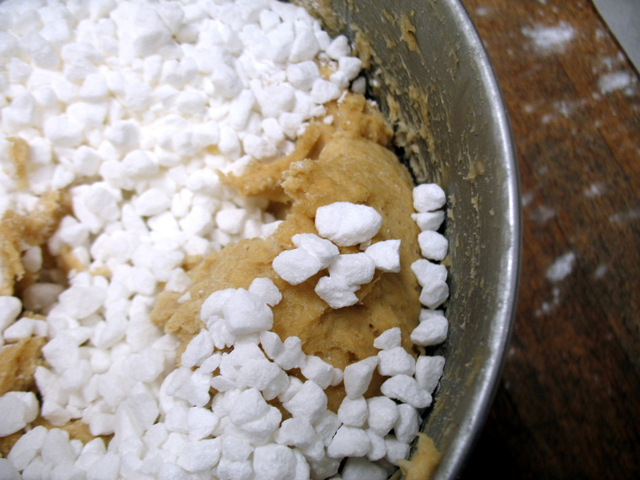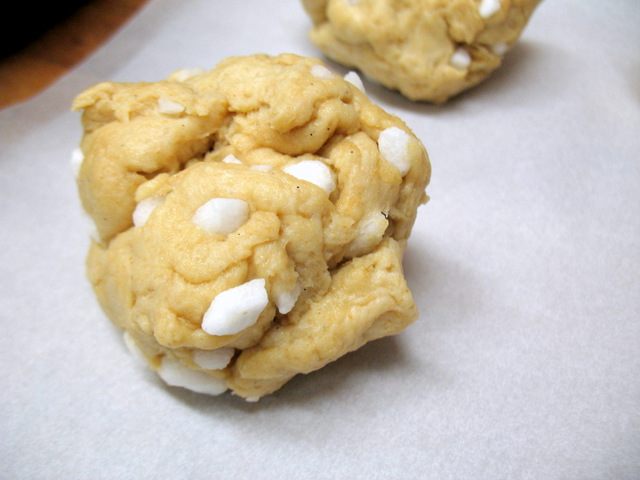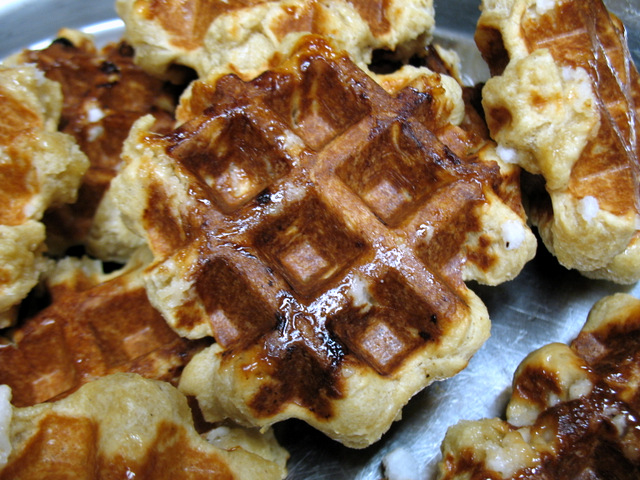
Growing up, my favorite waffles were, of course, Eggos. Flavorless, with a fun catch-phrase, they were the perfect vehicle for syrup and butter. It’s no wonder that I always preferred pancakes at renowned breakfast restaurants, like IHOP and Denny’s. In college, our cafeteria was equipped with a flip-waffle iron and a bowl of batter. You could make waffles at any time of day. But, after eyeing the thin batter and tasting the outcome, it was clear that these were merely pancakes posing as waffles.

Then, I moved to Massachusetts, where I learned a lot about food (Aunt Jemima's isn’t real maple syrup!?). I worked at a creperie as a barista who didn’t drink coffee. The crepes were filled with strange, exotic ingredients I had never heard of, like arugula and Brie. I also learned that the owner actually specialized in a variety of waffle called “Liège waffles” (also sometimes known as Belgian waffles). I had no interest in trying one - I knew what waffles were all about. But an extremely enthusiastic coworker convinced me to give it a go. She took the deep-pocketed rectangle, toasted it, got out the whipped cream and strawberries and impatiently watched as I took my first bite. And then my taste-buds exploded (with flavor, not literally exploded). Sweet, dense, yeasted, chewy, filled with sweet crunchy pockets of sugar that also caramelized on the surface of the waffle - why ruin this with whipped cream and strawberries? Eggos were no competition - in fact, I wasn’t even sure if they were really waffles at this point - these were the best waffles I had ever had!
That brings us up to date. This past holiday season at Formaggio Kitchen, I had numerous customers ask if we had something called Belgian Pearl Sugar. I looked into it and learned that this was the secret sweet crunch in the Liège waffles I remembered so fondly! I was thrilled and stocked the shop with it as quickly as possible, eager to try it out and spread the word about this magical stuff. This is where the journey for making the perfect waffle began.
 Belgian Pearl Sugar
Belgian Pearl Sugar
Pearl Sugar: crushed blocks of sugar; coarse, hard clumps of sugar that don’t melt at normal baking temperatures but will caramelize on the outside of waffles and create crunchy sweet spots on the inside.
Failing to find any recipes in my cookbooks, I began searching on the internet. After hours of research and reading through dozens of recipes, I narrowed my test recipes down to two candidates. Unfortunately, these waffles require patience - you need to start them a day in advance, or wake up before dawn to have them ready for breakfast. The first time I made them, I ate them with chicken (a classic pairing), collard greens and mashed sweet potatoes (props to the fiancé!) for a late dinner. That was the first two pounds of the eight I’ve gained on this waffle journey.
 Chicken and Belgian waffles - a classic combo.
Chicken and Belgian waffles - a classic combo.
Another requirement in waffle-making is a waffle iron. Mine is a CuisinArt Belgian Waffle Maker. Belgian waffle makers are typically square and have deeper pockets than those used for batter based waffles. It took a few test waffles to find the ideal temperature and cook-time, but I found that setting the heat just below 3 (the scale system is 1-5, 5 being hottest) for about 5 minutes allowed the waffles to fully cook through while also caramelizing a bit on the exterior.
The first batch of waffles I made were too dense and chewy. I also left the pearl sugar whole, and the caramelizing effect on the outside wasn’t nearly as intense as I’d hoped.

For the second batch, I tried cutting the bread flour with all-purpose flour (50/50 ratio), and although they weren’t as dense, they still weren’t light enough. The pearl sugar was an easy fix: I spread it out and crushed it with a rolling-pin. I also tried using a mortar and pestle and spice grinder, but both options made the sugar too fine. The rolling-pin created some powder and smaller nuggets of sugar that caramelized beautifully on the outside of the waffles – inside, there were still the sought-after crunchy sugar pockets.
After several more experiments in which I tested different flour ratios, I settled on a ratio of 1/2 bread flour and 1/2 pastry flour as the winning combination. However, if you want a very soft waffle, 1/3 bread flour and 2/3 pastry flour works well too. Personally, I thought it was a bit too soft to support the caramelized coating, falling apart easily – however, my fiancé was partial to this batch. I must admit - the pastry flour also adds a nice golden cream color.

3 different Belgian waffle doughs in progress: to the left, more yeast - top right, buttermilk - at bottom, a higher ratio pastry flour to bread flour and maple syrup.
There was one batch I added double the amount of yeast to, hoping to create an airier texture. I do not recommend that anyone follow in my footsteps! The finished dough tasted almost sour. The waffles also had layers (almost like a biscuit) when cut open, but the texture was far too doughy.
Buttermilk (in lieu of milk) didn’t seem to make much of a difference, other than curdling quickly when heated (this didn’t have any adverse effect on the dough). And, replacing the brown sugar and honey with maple syrup seemed like a great idea, but it lacked the hoped-for sweetness – instead, the almost burnt-like aspect of maple syrup flavor was what seemed to prevail – not particularly pleasant.
It has been a long (but tasty!) road to developing my go-to waffle - ultimately the majority of my inspiration and end result traces back to the Liege Waffle Recipe / Gaufre de Liège Recette Blog (that original recipe is available here).
Liège Waffles
Yields about 6 waffles (can be doubled, tripled, even quadrupled!)

1-1/2 tsps active dry yeast
1/4 cup whole milk or buttermilk
2 tbsp + 2 tsps water
1 cup pastry flour
1 cup bread flour
1 egg (room temperature, lightly beaten)
1 tbsp + 1 tsp light brown sugar
3/4 tsp salt
8 tbsp or 1 stick of room temperature butter
1 tbsp honey
1 tsp vanilla extract
1 tsp vanilla bean paste (or 1 more tsp. extract…I just like the way the beans look in the dough)
3/4 heaping cup pearl sugar, chopped
Whisk together the flours. Put the yeast in the bowl of an electric mixer with the dough hook attachment, or a large mixing bowl. Heat the milk and water to about 110-115°F. Mix in with the yeast. Add egg and 2/3 cup flour (or 1/3 the total amount of flour).
 Incorporating the butter, bit by bit.
Incorporating the butter, bit by bit.
Mix together just until combined. Then, gently sprinkle the rest of the flour on top of the mixture. Cover with cling wrap and let sit out for 1 hour to 1-1/2 hours, until the yeast is bubbling up over the top.
With the electric mixer on low-speed, add the brown sugar and salt. Add vanilla and honey. Then add the butter, 2 tbsps at a time.
At this point, the dough will be pretty sticky and hard to handle. After all the butter is added, let the dough rest for a minute. Then continue kneading (by mixer or by hand) for another 4-5 minutes. Let the dough rest, and repeat. Eventually the dough will cling together and form a large ball, coming away from the sides of the bowl. Be patient, it will happen!
 The dough coming away from the sides of the bowl to form a ball.
The dough coming away from the sides of the bowl to form a ball.
When the dough is ready, cover with plastic wrap and let rise at room temperature (between 64-70°F is best) until about doubled in size. This can take up to 4 hours, and probably won’t take less than 3 hours.
(Note: you can also retard the dough by putting it in the fridge after letting it rise for 2-3 hours, taking it out the following day to finish. However, the dough becomes stiffer and takes much longer to get to room temperature. After trying it both ways, I found that letting the dough fully rise creates a fluffier waffle.)
When the dough has fully risen, punch it down and mix in the pearl sugar by hand. You will get extremely buttery, but this is the best way to ensure the sugar gets evenly distributed - plus the dough feels really nice. Let it rest for 15 minutes.
 Risen and ready for the waffle iron!
Risen and ready for the waffle iron!
In the meantime, heat up your waffle iron. On my waffle iron, I like the setting at about 2¾ (i.e. just shy of the 3), but change the temperature in accordance with your waffle preference and your equipment – this may take some experimenting. If you have a kitchen scale, start dividing the dough into 112 gram (4 ounce) pieces. If not, make balls of dough that are 3 heaping tablespoons each in size.
 The dough portioned out.
The dough portioned out.
When the iron is heated, press a ball into the middle of each waffle square. Close the iron and let cook for about 5 minutes, depending on how well-done you like your waffles.
Et, voilà! You have made the amazing Liège waffles!
 Hot off the waffle iron.
Hot off the waffle iron.
Now, the trickiest part is cleaning the iron. I’ve tried using a rag to wash away the sticky sugar while it’s still warm; a knife to chip away at the solid pieces after they have cooled; scrubbing with a sponge. Nothing seems to work well, so I’d love some suggestions!
 A waffle spread!
A waffle spread!
You can freeze the waffles by wrapping them tightly in plastic wrap and either putting them in ziplock bags or plastic bags. Or, best of all - eat as is, warm off the waffle iron! No toppings are necessary but you can go all out (as we did at staff tastings!) with whipped cream, fresh berries, candied kumquats, blood orange marmalade, lemon curd and/or cinnamon sugar.

Stay tuned for a gluten-free waffle recipe, a sourdough waffle recipe, and a bacon and waffle recipe…
Author - Alyssa Persinger was the former Bakery Manager at Formaggio Kitchen Cambridge.

